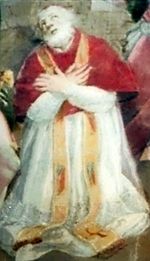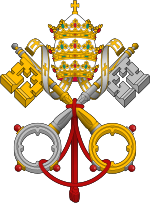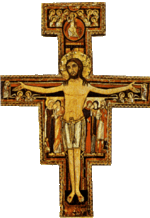Pope Anicetus
| Anicetus | |
|---|---|
 |
|
| Papacy began | ca. 154 |
| Papacy ended | ca. April 20, 167 |
| Predecessor | Pius I |
| Successor | Soter |
| Personal details | |
| Birth name | Anicetus |
| Born | ??? Emesa, Syria |
| Died | ca. April 20, 167 Rome, Roman Empire |
| Papal styles of Pope Anicetus |
|
|---|---|
 |
|
| Reference style | His Holiness |
| Spoken style | Your Holiness |
| Religious style | Holy Father |
| Posthumous style | Saint |
Pope Saint Anicetus was Pope of the Catholic Church from about 150 to about 167 (the Vatican's list cites 150 to 167 or 153 to 168). His name is Greek for unconquered (ἀ-νίκητος). He was a Syrian from the city of Emesa (modern-day Hims), Syria.
According to Irenaeus, it was during his pontificate that the aged Polycarp of Smyrna, a disciple of John the Evangelist, visited the Roman Church. St Polycarp and St Anicetus discussed the celebration of Passover. Polycarp and his Church of Smyrna celebrated the crucifixion on the fourteenth day of Nisan, which coincides with Pesach or Passover. The day of the week was not important in that part of the East. On the other hand, the Roman Church celebrated the Pasch on Sunday—the weekday of Jesus' resurrection. The two did not agree on a common date, but Anicetus conceded to St Polycarp and the Church of Smyrna the ability to retain the date to which they were accustomed. The controversy was to grow heated in the following centuries.
The Christian historian Hegesippus also visited Rome during Anicetus' pontificate. This visit is often cited as sign of the early importance of the Roman See.
St Anicetus was the first Roman Bishop to condemn heresy by forbidding Montanism. He also actively opposed the Gnostics and Marcionism. According to Liber Pontificalis, Anicetus decreed that priests are not allowed to have long hair (perhaps because the Gnostics wore long hair).
According to legend, St Anicetus suffered martyrdom during the reign of the Roman Co-Emperor Lucius Verus, but there are no historical grounds for this account.[1] 16, 17 and 20 April are all cited as the date of his death, but 20 April is celebrated as his feast day.[2] Before 1970, the date chosen was 17 April.[1]
References
Bibliography
 "Pope St. Anicetus". Catholic Encyclopedia. New York: Robert Appleton Company. 1913.
"Pope St. Anicetus". Catholic Encyclopedia. New York: Robert Appleton Company. 1913.- Duff, Eamon. Saints and Sinners: A History of the Popes, Yale University Press, 2001, p. 13. ISBN 0300091656
- Maxwell-Stuart, P. G. Chronicle of the Popes: The Reign-by-Reign Record of the Papacy from St. Peter to the Present, Thames & Hudson, 2002, p. 19. ISBN 0500017980.
External links
- "Pope St. Anicetus". Catholic Encyclopedia. New York: Robert Appleton Company. 1913. http://www.newadvent.org/cathen/01514a.htm.
| Catholic Church titles | ||
|---|---|---|
| Preceded by Pius I |
Bishop of Rome Pope 154–167 |
Succeeded by Soter |
|
|||||||||||||||||||||||||||||||||||||||||||||
|
|||||||||||||||||||||||||||||||||||||||||

